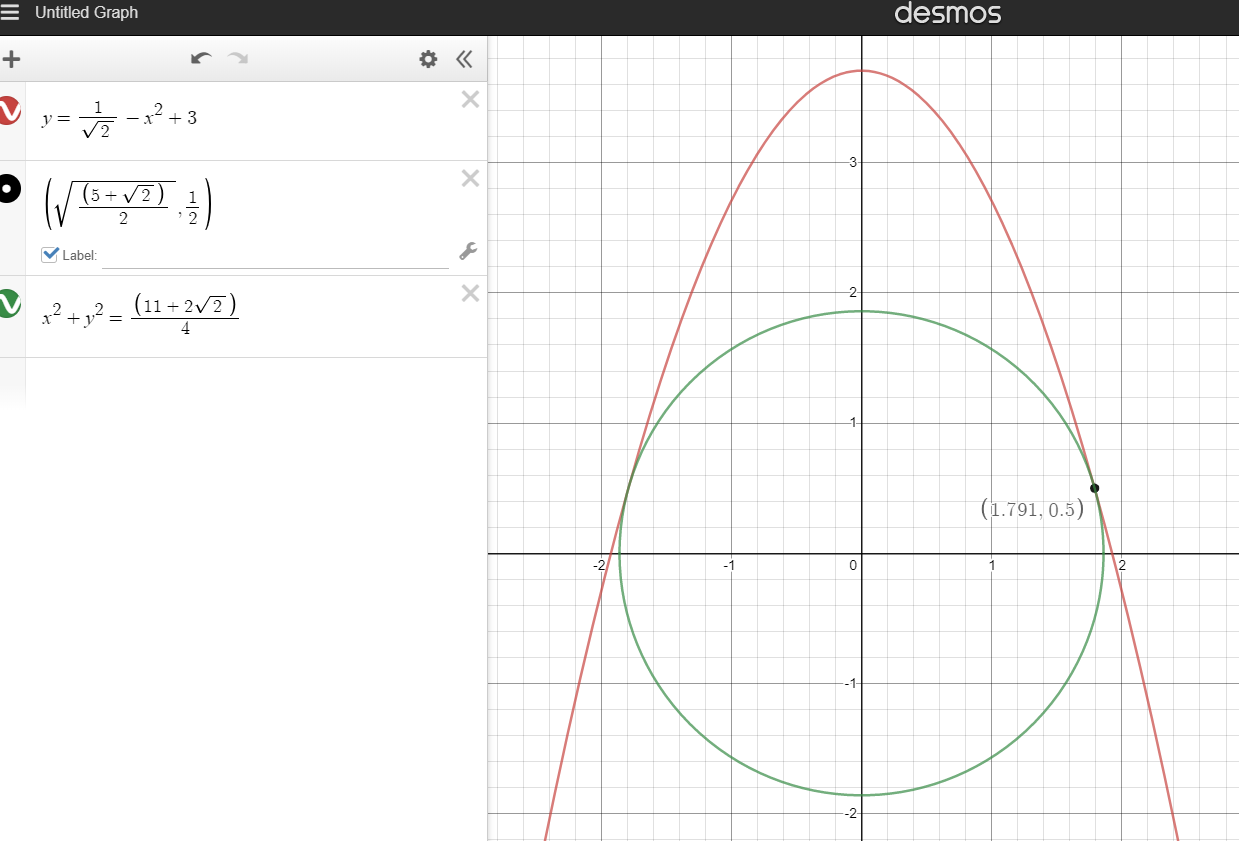\(y=\frac{1}{\sqrt2}-(x^2-3)\\ y=-x^2+3+\frac{1}{\sqrt2}\\ y=-x^2+\frac{6+\sqrt2}{2}\\ \)
This is a concave down parabola with y intercept \(\frac{6+\sqrt2}{2}\approx 3.707\)
And the y axis is the axis of symmetry.
A general point on this parabola is \((x,\left[-x^2+\frac{6+\sqrt2}{2}\right])\\\)
The distance square from (0,0) to the parabola for any given x value will be
\(d^2=D=(x-0)^2+(-x^2+\frac{6+\sqrt2}{2}-0)^2\\ D=x^2+(-x^2+\frac{6+\sqrt2}{2})^2\\ D=x^2+x^4+(-2*\frac{6+\sqrt2}{2})x^2+(\frac{6+\sqrt2}{2})^2\\ D=x^2+x^4+(-6-\sqrt2)x^2+(\frac{36+2+12\sqrt2}{4})\\ D=x^4+(1-6-\sqrt2)x^2+(\frac{19}{2}+3\sqrt2)\\ D=x^4+(-5-\sqrt2)x^2+(\frac{19}{2}+3\sqrt2)\\~\\ D'=4x^3+2(-5-\sqrt2)x\\ \text{D will be minimum when }D'=0\\ 0=4x^3+2(-5-\sqrt2)x\\ \text{I know just from thinking about the graph that }\;x\ne0\\ 0=4x^2+2(-5-\sqrt2)\\ 0=4x^2-10-2\sqrt2\\ 4x^2=10+2\sqrt2\\ 2x^2=5+\sqrt2\\ x^2=\frac{5+\sqrt2}{2}\\ x=\pm\sqrt{\frac{5+\sqrt2}{2}}\\\)
So the distance will be minimum when \(x=\pm\sqrt{\frac{5+\sqrt2}{2}}\\\)
Sub to get y
\(y=-\left[\pm\sqrt{\frac{5+\sqrt2}{2}}\right]^2+\frac{6+\sqrt2}{2}\\ y=-\left[\frac{5+\sqrt2}{2}\right]+\frac{6+\sqrt2}{2}\\ y=\frac{-5-\sqrt2}{2}+\frac{6+\sqrt2}{2}\\ y=\frac{1}{2}\)
So the closest points on the parabola to (0,0) are \(\left(\sqrt{\frac{5+\sqrt2}{2}},\frac{1}{2}\right)\quad and \quad \left(-\sqrt{\frac{5+\sqrt2}{2}},\frac{1}{2}\right)\)
So the distance from either both these points to the origin will be
\(d=\sqrt{ \left(\frac{5+\sqrt2}{2}\right) + \frac{1}{4} }\\ d=\sqrt{ \left(\frac{10+2\sqrt2+1}{4}\right) }\\ d=\sqrt{ \left(\frac{11+2\sqrt2}{4}\right) }\\ smallest\;\; distance=\frac{\sqrt{ 11+2\sqrt2 }}{2}\\ smallest\;\; distance\approx 1.86\;units\)
Here is the related graph:

LaTex:
y=\frac{1}{\sqrt2}-(x^2-3)\\
y=-x^2+3+\frac{1}{\sqrt2}\\
y=-x^2+\frac{6+\sqrt2}{2}\\
d^2=D=(x-0)^2+(-x^2+\frac{6+\sqrt2}{2}-0)^2\\
D=x^2+(-x^2+\frac{6+\sqrt2}{2})^2\\
D=x^2+x^4+(-2*\frac{6+\sqrt2}{2})x^2+(\frac{6+\sqrt2}{2})^2\\
D=x^2+x^4+(-6-\sqrt2)x^2+(\frac{36+2+12\sqrt2}{4})\\
D=x^4+(1-6-\sqrt2)x^2+(\frac{19}{2}+3\sqrt2)\\
D=x^4+(-5-\sqrt2)x^2+(\frac{19}{2}+3\sqrt2)\\~\\
D'=4x^3+2(-5-\sqrt2)x\\
\text{D will be minimum when }D'=0\\
0=4x^3+2(-5-\sqrt2)x\\
\text{I know just from thinking about the graph that }\;x\ne0\\
0=4x^2+2(-5-\sqrt2)\\
0=4x^2-10-2\sqrt2\\
4x^2=10+2\sqrt2\\
2x^2=5+\sqrt2\\
x^2=\frac{5+\sqrt2}{2}\\
x=\pm\sqrt{\frac{5+\sqrt2}{2}}\\
y=-\left[\pm\sqrt{\frac{5+\sqrt2}{2}}\right]^2+\frac{6+\sqrt2}{2}\\
y=-\left[\frac{5+\sqrt2}{2}\right]+\frac{6+\sqrt2}{2}\\
y=\frac{-5-\sqrt2}{2}+\frac{6+\sqrt2}{2}\\
y=\frac{1}{2}
\left(\sqrt{\frac{5+\sqrt2}{2}},\frac{1}{2}\right)\quad and \quad \left(-\sqrt{\frac{5+\sqrt2}{2}},\frac{1}{2}\right)
d=\sqrt{ \left(\frac{5+\sqrt2}{2}\right) + \frac{1}{4} }\\
d=\sqrt{ \left(\frac{10+2\sqrt2+1}{4}\right) }\\
d=\sqrt{ \left(\frac{11+2\sqrt2}{4}\right) }\\
smallest\;\; distance=\frac{\sqrt{ 11+2\sqrt2 }}{2}\\
smallest\;\; distance\approx 1.86\;units
![]() , but here is a trickier practice problem for you (refer to website linked above if confused). Use the same problem that you stated above, BUT, instead, you can't repeat digits. (maybe not that much trickier, but you should try it.))
, but here is a trickier practice problem for you (refer to website linked above if confused). Use the same problem that you stated above, BUT, instead, you can't repeat digits. (maybe not that much trickier, but you should try it.))